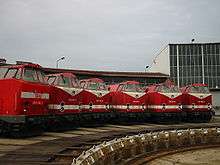DR Class 119
| DR Class 119 | |
|---|---|
.jpg) | |
| Number(s) | DR 119 001–200 DR/DB 219 003–200 DB 229 ... |
| Quantity | 200 |
| Manufacturer | "23 August" Bucharest Locomotive Works |
| Year(s) of manufacture | 1976–85 |
| Retired | by 2006 |
| Axle arrangement | C’C’ |
| Gauge | 1,435 mm (4 ft 8 1⁄2 in) |
| Length over buffers | 19,500 mm |
| Service weight | 99 t / 101 t |
| Axle load | 16 t |
| Top speed | 120 km/h / 140 km/h |
| Installed power | 2 × 990 kW / 1,100 kW / 1,380 kW /1,500 kW |
| Starting tractive effort | 220 kN / 270 kN |
| Driving wheel diameter | 1,000 mm |
| Power transmission | hydrodynamic |
| Tank capacity | 4,000 l |
| Brakes | Compressed air KNORR & DAKO driver's and auxiliary brake valves |
| Train heating | electric |

The DR Class 119 was an East German Deutsche Reichsbahn diesel locomotive that was built in Romania. When the Deutsche Bahn AG formed up in 1993 it was redesignated as DBAG Class 219.
They were nicknamed "U-boats" or "Ceaușescu's revenge" (Ceaușescus Rache) - the latter referring to the numerous technical problems the engines suffered before redesign.
History
The Class 119 was basically a development of the successful Class 118. In the late 1970s the DR needed locomotives with electric train heating, an axle load (Achsfahrmasse) of under 16 t and a power output of over 2,000 horsepower. As a result of the Comecon agreements, the East German economy was not allowed to build diesel locomotives with more than 1,500 horsepower. The locomotive builders of the Soviet Union could only supply heavy engines - the Classes 130-132 and 142. The only engine builder, who also wanted to use the "construction kit" (Baukasten) principle was the "23rd August" Locomotive Works, Bucharest, in Romania. The Romanian manufacturer declared itself also ready to install diesel engines produced in East Germany. The installation of such engines did not happen, however, because there were coordination problems in East Germany's national planning commission. In order the fulfil the order, the Bucharest factory installed engines under licence from the West German manufacturer, MTU.
Other countries in Comecon also received subcontractor orders. East Germany itself supplied inter alia hydrodynamic transmissions and axle motors.
The DR procured 200 locomotives from 1976 to 1985. The locomotive drive was, however, plagued by shortcomings and problems from the start. In its early days, 50% of the locomotives were in the workshops at any one time.
Literature
- Köhler, Kurt; Stange, Andreas (2004). Die Baureihen 119, 219 und 229 Rumänische Dieselloks für die Deutsche Reichsbahn (in German). Freiburg: EK-Verlag. ISBN 3-88255-129-1.
- Buchner, Mathias, ed. (2002). Die Baureihe 219 - Unterwegs mit den Reichsbahn-"U-Booten" (in German). Eisenbahn-Bildarchiv, EK-Verlag. ISBN 978-3-88255-340-6.
- Schönheit, Walter (2002). "Baureihe 219. Im Führerstand". Lok Magazin (in German). München: GeraNova Zeitschriftenverlag GmbH. 41 (255): 52–55. ISSN 0458-1822.
- Endisch, Dirk (2003). ""U-Boote" tauchen ab. Baureihe 219/229". Lok Magazin (in German). München: GeraNova Zeitschriftenverlag GmbH. 42 (259): 6–9. ISSN 0458-1822.
- "Modernisierung einer Lokomotive der Baureihe 219". Eisenbahn-Revue International (in German). 6: 251–ff. 2001. ISSN 1421-2811.
External links
-
 Media related to DR Class 119 at Wikimedia Commons
Media related to DR Class 119 at Wikimedia Commons - The Class 219/229 in numbers, facts and pictures
- The BR 119 of the Deutsche Reichsbahn
- Bahn-Galerie.de - Classes 219 and 229